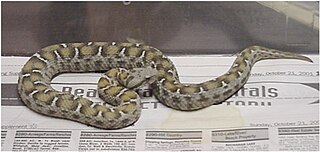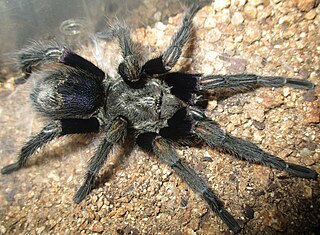
Gigantopithecus was a genus of ape from roughly 2 million to 350,000 years ago during the Early to Middle Pleistocene of southern China, represented by one species, Gigantopithecus blacki. Potential identifications have also been made in Thailand, Vietnam, and Indonesia. The first remains of Gigantopithecus, two third molar teeth, were identified in a drugstore by anthropologist Ralph von Koenigswald in 1935, who subsequently described the ape. In 1956, the first mandible and more than 1,000 teeth were found in Liucheng, and numerous more remains have since been found in at least 16 sites. Only teeth and four mandibles are known currently, and other skeletal elements were likely consumed by porcupines before they could fossilise. Gigantopithecus was once argued to be a hominin, a member of the human line, but it is now thought to be closely allied with orangutans, classified in the subfamily Ponginae.

Eurema blanda, the three-spot grass yellow, is a small butterfly of the family Pieridae which is found in Sri Lanka, India and southeast Asia.

Montivipera albizona, the central Turkish mountain viper, is a viper species endemic to the mountainous regions of central Turkey. Like all other vipers, it is venomous. No subspecies are currently recognized.

Zygoballus is a genus of jumping spiders found in North and South America.

Acytolepis puspa, the common hedge blue, is a small butterfly found in Cambodia, India, Myanmar, Thailand, Yunnan, Taiwan, Sri Lanka, Philippines, Borneo and New Guinea that belongs to the lycaenids or blues family. The species was first described by Thomas Horsfield in 1828.

The Indian fritillary is a species of butterfly of the nymphalid or brush-footed family. It is usually found from south and southeast Asia to Australia.

Euathlus is a genus of South American tarantulas that was first described by Anton Ausserer in 1875. These spiders are medium sized and are usually found in high elevations in the Andes. It is a senior synonym of Paraphysa, and was formerly considered a senior synonym of Brachypelma, but this was later rejected.
Acanthogonatus birabeni is a mygalomorph spider of Argentina, named after Max Birabén, an Argentinian arachnologist. It differs from others in the patagonicus group by its smaller size and by the less developed bulb keels.
Chaco tucumana is a species of mygalomorph spiders of Argentina, named after its type locality: Tucumán. This species differs from C. obscura in the shorter male embolus and the shorter female spermathecal ducts. From other species of the genus it differs in its dark uniform color, the flexible anterior female tarsi, the denser scopulae on the posterior tarsi, and the female spermathecae without a basal protuberance. As in C. obscura, smaller specimens are much lighter in color, and it has darker spots that are evident on the sides of its cephalic region, the apex of femora, base of the patellae and lateral tibiae and dorsal abdomen. Larger specimens are much darker, almost black, with no visible pattern.

Dreadnoughtus is a genus of titanosaurian sauropod dinosaur containing a single species, Dreadnoughtus schrani. D. schrani is known from two partial skeletons discovered in Upper Cretaceous rocks of the Cerro Fortaleza Formation in Santa Cruz Province, Argentina. It is one of the largest terrestrial vertebrates known, with the immature type specimen measuring 26 metres (85 ft) in total body length and weighing 48–49 metric tons. D. schrani is known from more complete skeletons than any other gigantic titanosaurian.
Sickius is a genus of tarantulas. It has a single species, Sickius longibulbi. It is endemic to Brazil.
Hapalotremus is a genus of South American tarantulas in the Theraphosinae subfamily that was first described by Eugène Louis Simon in 1903. They have red or white Type III urticating hairs, up to 1.2 millimetres (0.047 in), with a fine point and barbs along at least half of the lower part. The tibial apophysis is branched twice, and there is a conspicuous subapical keel on the male's embolus.
Rick C. West is a Canadian arachnologist and an expert on the taxonomy of tarantula spiders. West was born in Victoria, British Columbia. He has been interested in spiders since childhood, and collected his first tarantula, Aphonopelma eutylenum, at the age of 13. He worked primarily as a Chief Constable for a local Animal Humane Society, but also have been involved with the collecting, breeding, rearing and photography of theraphosid spiders. West has traveled to over 27 countries to document and study them in their environment, has been a host, presenter and co-producer in several tarantula documentaries and has also described several genera and species.

Patricio Lorente is an Argentine scholar and General Secretary of the National University of La Plata.

Calathotarsus simoni is a species of spider in the family Migidae, found in Argentina. Typical to the trapdoor families of spiders, rather than build nests, this spider creates burrows hidden by a door constructed of nearby detritus camouflaging its location.
Sphegina (Asiosphegina) carinata is a species of hoverfly in the family Syrphidae found in Kambaiti Pass, Myanmar, a montane forest with swampy areas and streams located 2000 meters above sea level.
Pachagnathus is an extinct genus of non-pterodactyloid pterosaur from the late Norian–early Rhaetian-aged Quebrada del Barro Formation of Argentina. It lived in the Late Triassic period, and is one of the only known definitive Triassic pterosaurs from the southern hemisphere. It is also one of the few known continental Triassic pterosaurs, indicating that the absence of early pterosaurs in both the southern hemisphere and terrestrial environments is likely a sampling bias, and not a true absence.
Plesiopelma paganoi is a tarantula in the Plesiopelma genus, this tarantula was first described by Nelson Ferretti and Jorge Barneche in 2014. It is named in honor of Luis G. Pagano, Argentinean ornithologist who helped to collect this species. It is found in Argentina, in the Salta province, next to the south Bolivia border.
Hapalotremus chespiritoi is a tarantula in the Hapalotremus genus, first described by Nelson Ferretti, Patricio E. Cavallo, Juan C. Chaparro, Duniesky Ríos Tamayo, Tracie A. Seimon and Rick C. West in 2018. It is found in Peru, Patambuco, very close to Sicuani. This tarantula is named after Roberto Gómez Bolaños. The shape of the spermatheca of female of Hapalotremus chespiritoi resembles the small antennae of el "Chapulín Colorado", a comical superhero created by R.G. Bolaños.









